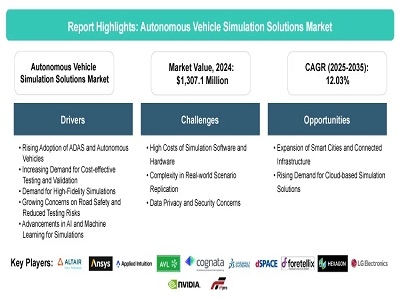According to BIS Research the autonomous vehicle simulation solutions market was valued at $1,307.1 million in 2024 and is expected to grow at a CAGR of 12.03% and reach $4,614.2 million by 2035.What is the Autonomous Vehicle Simulation Solutions
Autonomous vehicle simulation solutions represent a critical component in the advancement of automotive technology. These platforms generate highly realistic virtual environments that accurately mirror real-world driving conditions, thereby enabling manufacturers to rigorously test, validate, and optimize both the software and hardware elements integral to self-driving systems.
The autonomous vehicle simulation solutions market addresses current regulatory demands and the pursuit of fully autonomous mobility by encompassing a wide range of simulation tools, from scenario modeling to hardware-in-the-loop setups.
Key Components
Environment Simulation: Replicates diverse driving conditions such as urban, highway, rural, and off-road settings.
Sensor Simulation: Models the behavior of sensors like LiDAR, radar, cameras, and GPS.
Scenario Generation: Creates millions of possible driving situations, including rare and dangerous scenarios that are difficult to reproduce in real life.
AI & Algorithm Testing: Evaluates the vehicle’s decision-making, perception, and control algorithms.
Digital Twin Technology: Mirrors real-world systems in a virtual space for precise analysis.
Speed: Accelerates the development cycle by rapidly iterating on software updates and system improvements.
Why Simulation Is Critical to Autonomous Driving
1. Safety First
Testing autonomous vehicles in the real world poses inherent safety risks, especially when dealing with unpredictable scenarios like sudden pedestrian crossings or erratic drivers. Simulation allows developers to repeatedly test these dangerous situations without any real-world consequences, thereby ensuring safer system development.
2. Cost and Time Efficiency
Conducting millions of miles of real-world testing is not only expensive but also time-consuming. Simulation dramatically reduces costs by allowing developers to virtually test and refine driving algorithms at scale, cutting development timelines and accelerating innovation.
3. Comprehensive Testing Across Edge Cases
Edge cases are rare but critical scenarios are notoriously difficult to capture in real-world driving. Simulation platforms can generate and test thousands of these edge cases, helping ensure that autonomous vehicles are robust enough to handle the unexpected.
4. Sensor and Perception Validation
Simulation tools can mimic the behavior of various sensors such as LiDAR, radar, cameras, and GPS. This enables developers to assess how accurately the vehicle perceives its environment and how effectively it makes decisions based on that perception.
How is the Autonomous Vehicle Simulation Solutions Market Segmented?
1 By End Users
• Automotive OEMs and Autonomous Driving Technology Development Companies
• Tier-1 and Tier-2 Component Manufacturers
• University and Research Centers, Technology Companies, and Regulatory Bodies
Automotive OEMs and Autonomous Driving Technology Development Company to Lead the Autonomous Vehicle Simulation Solutions Market
2 By Level of Autonomy
• Levels 1 and 2 (Partially Assisted Driving)• Levels 3 and 4 (Semi to High Automation)• Level 5 (Full Automation)
Levels 1 and 2 (Partially Assisted Driving) Vehicles to Lead the Autonomous Vehicle Simulation Solutions Market (by Level of Autonomy)
3 By Product
•Software
•Services
Software Segment to Lead the Autonomous Vehicle Simulation Solutions Market
4 By Deployment
•On-Premises
•Cloud
On-Premises Autonomous Vehicle Simulation Solutions to Lead the Autonomous Vehicle Simulation Solutions Market (by Deployment)
Segmentation 5: By Region
North America: U.S., Canada, and Mexico
Europe: Germany, France, U.K., Spain, and Rest-of-Europe
Asia-Pacific: China, Japan, South Korea, and Rest-of-Asia-Pacific
Rest-of-the-World: Latin America and Middle East and Africa
North America to Dominate the Autonomous Vehicle Simulation Solutions Market
Request a Detailed Sample on the Autonomous Vehicle Simulation Solutions Market!
Demand Drivers
Rising adoption of ADAS and autonomous vehicle
Increasing demand for cost effective testing and validation
Demand for high fidelity simulation
Growing concerns on road safety and reduced testing risks
Advancements in machine learning and AI learning for simulation
Industrial Impact
The Autonomous Vehicle Simulation Solutions market also supports the growth of related sectors, including the satellite industry, where power solutions are critical for long-duration space missions and satellite operations. Innovations in space power systems lead to advancements in energy efficiency, which influence global energy markets and the development of cutting-edge technologies.
Industrially, the demand for lightweight, efficient, and durable power technologies is accelerating R&D in solar cells, battery storage, fuel cells, and nuclear energy.
Furthermore, the growing Autonomous Vehicle Simulation Solutions market is fostering high-tech manufacturing, supply chain expansion, and specialized component development, thereby creating new business opportunities and jobs across the globe
Get Detailed Insights on Automotive Mobility Market
Technological Innovations
The Autonomous Vehicle Simulation Solutions sector is undergoing a technological renaissance. Key trends include
High-Efficiency Solar Cells: Such as triple-junction gallium arsenide cells that deliver greater power per surface area.
Solid-State Batteries: Promising higher energy density and longer life cycles.Modular Power Systems: Offering scalability and ease of integration for various mission profiles.
Nuclear Power for Deep Space: With RTGs and small modular reactors under development for lunar and Martian operations.
Emerging trends such as on-orbit servicing, space-based manufacturing, and lunar habitation will create new avenues for power supply development. Moreover, as sustainability becomes a key focus in space missions, there will be a greater emphasis on reusable and energy-efficient power technologies.
Key Players
Altair Engineering, Inc.
ANSYS, Inc
Applied Intuition, Inc.
AVL List GmbH
Cognata
Dassault Systèmes
dSPACE GmbH
Foretellix
and many others
The Future Powering a New Space Era
The future of autonomous vehicle simulation solutions is poised for rapid advancement as the automotive industry races toward fully autonomous mobility.
Key trends shaping the future include:
Hyper-Realistic Digital Twins: Simulations will increasingly replicate real-world cities and traffic conditions in extraordinary detail, enabling localized testing and scenario-specific optimization.
AI-Driven Scenario Generation: Advanced AI will automatically generate complex and unpredictable scenarios that challenge autonomous systems beyond pre-programmed test cases.
Integration with Real-World Data: Simulators will seamlessly combine data from real-world driving to continuously refine and improve virtual models.
Cloud-Based Scalability: The rise of cloud computing will enable massive parallel simulations, accelerating validation cycles across millions of scenarios in less time.
Collaboration Across Stakeholders: Automakers, tech firms, regulators, and city planners will increasingly collaborate through shared simulation platforms to ensure safety, compliance, and urban integration.
Conclusion
Autonomous vehicle simulation solutions have emerged as a cornerstone of safe, efficient, and scalable self-driving technology development. By enabling exhaustive testing in virtual environments, these solutions help address the limitations of real-world testing, reducing risks, costs, and time-to-market for autonomous vehicles.
AI-driven scenario creation, and greater integration with real-world data. This progression ensures that simulation remains vital not just for development, but also for regulatory validation and public confidence.
Media Contact
Company Name: BIS Research
Contact Person: Bhavya Banga
Email: Send Email
Phone: +1-510-404-8135
Address:39111 PASEO PADRE PKWY STE 313, FREMONT CA 94538
City: Fremont
State: California
Country: United States
Website: https://bisresearch.com/industry-report/autonomous-vehicle-simulation-solution-market.html







